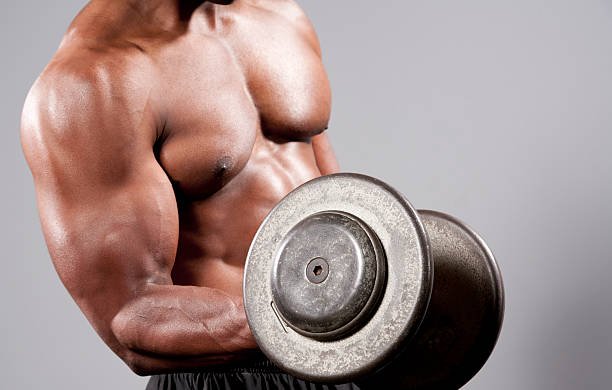Table of Contents
With the help of our in-depth tutorial on Calisthenics Bicep Workout, set off on a revolutionary path to develop strong, defined biceps. This article uses the art of calisthenics to reveal the secrets of twelve intense exercises that will blow your biceps off. Our carefully chosen collection of workouts offers significant bicep growth by utilizing the strength of your body weight, regardless of your level of fitness.
Examine the biceps muscle’s dynamic potential and the significance of different grips and angles for the best possible engagement. Come along as we unravel the secrets of biceps anatomy and function, so you can make the most out of this important upper body muscle group.
Unveiling the Intricacies of Biceps Anatomy and Function
There are two separate heads to the biceps muscle, which is an important component of upper arm dynamics: the long head and the short head. The scapula and coracoid process are the origin of these heads, which converge to produce a strong tendon that enters into the radius bone. This complex anatomical configuration enables the biceps to perform critical actions necessary for arm function.
The muscle in the biceps facilitates smooth movements by coordinating with other muscles in the upper arm in a fluid way. Because of its complicated design and multifunctional use, the arm’s development is not only aesthetically pleasing but also essential for everyday tasks, underscoring the need of maintaining its strength and flexibility.
By solving its secrets, we can better understand the biceps muscle’s complex architecture and vital role in our physical capabilities. Understanding the subtleties of the biceps’ architecture becomes essential as we get deeper into fitness and exercise regimens in order to maximize its potential and guarantee top performance in a variety of sports.
Dynamic Capabilities of the Biceps Muscle
One of the upper arm’s most powerful muscles, the biceps muscle demonstrates its adaptability in three main ways:
1. Elbow flexion: This basic movement, which is used in tasks like lifting items, is the contraction of the biceps, which causes the forearm to bend toward the upper arm.
2. Forearm supination is an example of an outward rotation that has functional value beyond standard strength training. It enables the biceps to play a crucial part in tasks requiring twisting or turning actions.
3. Shoulder flexion: The biceps’ often-ignored motion demonstrates how they work to elevate the arm forward, which enhances their involvement in whole upper body movements.
The complex architecture of the biceps and their crucial function in fostering smooth and controlled upper body movement are highlighted by this trio of exercises.
The value of utilizing various grips and angles.
Experimenting with different grips and angles throughout exercises is essential to maximize the development of your calisthenics bicep workout. Comprehensive muscle engagement is ensured by experimenting with angles and incorporating varied grips, such as underhand and overhand.
Different grips work on different parts of the biceps, encouraging a complete growth in both appearance and functionality. Moreover, altering angles promotes growth from multiple directions and inhibits muscle adaption, resulting in balanced and well-defined arms.
Calisthenics Bicep Workout
1. Chin-ups
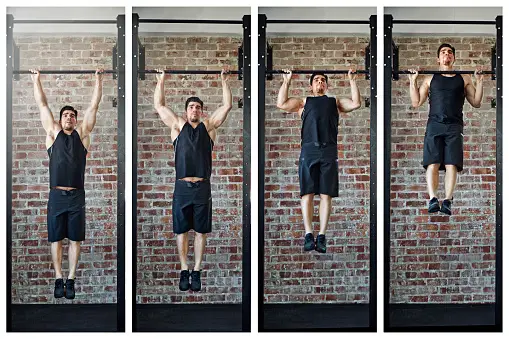
An explosive upper-body workout that is a powerful mainstay of any fitness program, particularly for building strong biceps and strengthening the upper body. Although it works a variety of muscle groups, the biceps, back, and shoulders receive the most attention during this compound exercise.
Brief Description:
Chin-ups are lifting your body up till your chin is above the bar while holding an overhead bar with your palms facing you and shoulder-width apart. Different muscle fibers are activated throughout the controlled ascent and descent, which promotes the development of strength and muscular mass.
Step-by-Step Guide:
1. Grasp Positioning: Place your hands on the bar with your palms facing you.
2. Start the Pull: Pull your body upward by using your back and biceps muscles.
3. Chin Over the Bar: Raise your chin above the bar, highlighting your biceps’ contraction.
4. Controlled Descent: Feel the stretch in your muscles as you gently lower your body.
5. Repeat: To get the most out of the benefits, try doing this several times.
Including chin-ups in your exercise regimen helps you develop practical strength in addition to cosmetic benefits. This activity is a flexible and essential complement to your calisthenics bicep workout because it surpasses conventional physical limitations.
2. Supinated Grip Inverted Rows
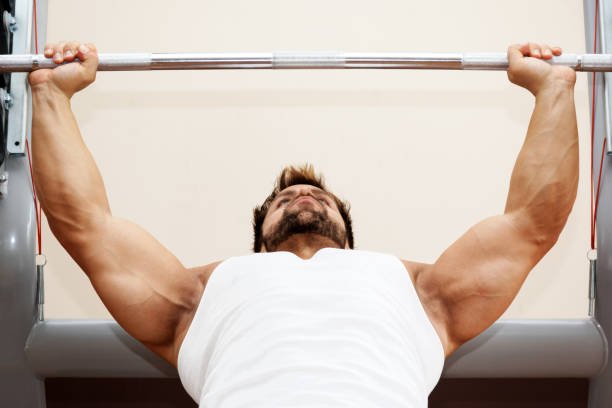
These are a flexible and powerful upper body workout that work a variety of muscle groups, mainly the shoulders, biceps, and back. With a supinated (palms facing you) grip, this unusual take on the classic inverted row adds another level of complexity, boosting bicep engagement and improving workout performance overall.
Brief Description:
Take an underhand grip, place yourself underneath, and secure a bar at waist height to do supinated grip inverted rows. Pull your chest toward the bar while maintaining a straight torso and fully extended arms. Make sure your elbows are kept close to your sides. Because of the supinated hand position, this exercise not only works your upper back muscles but also emphasizes bicep contraction.
Step-by-Step Guide:
1. Setup: To ensure stability, position the bar at waist height.
2. Hold: With your hands facing you, take an underhand hold on the bar.
3. Body Alignment: Keep your torso and feet in a straight line.
4. Pulling Motion: Pull your chest in the direction of the bar by using your back and biceps.
5. Controlled Descent: Return to the starting position by lowering your body with control.
6. Repetition: Focus on form and muscular engagement while aiming for a predetermined amount of repetitions.
Supinated grip inverted rows are a great way to add strength and stability to your exercise while also developing a well-rounded body. This effective and captivating exercise can help you achieve a more toned upper body.
3. Towel Pull-Ups
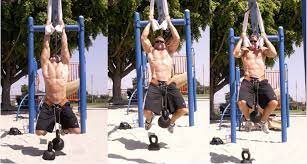
These are a novel and difficult take on the classic pull-up that will push the limits of your upper body training. This exercise is a versatile addition to your regimen because it works not just the usual muscle groups used in pull-ups but also increases the amount of work that must be done from your forearms and grip strength.
Brief Description:
1. Setup: Cover a sturdy pull-up bar with a towel.
2. Grip: Make a firm yet difficult hold by grasping both ends of the towel.
3. Body Alignment: Maintain a straight posture while hanging with your arms fully extended.
4. Pulling Motion: Pull your chest toward the bar by using your forearms, biceps, and back.
5. Controlled Descent: Return to the starting position by lowering your body with control.
6. Repetition: As strength increases, progressively increase the number of repetitions you aim for.
Include towel pull-ups in your calisthenics bicep workout routine for a distinct and efficient upper body exercise that develops excellent grip strength in addition to improving muscular growth, which helps you build a robust and well-rounded body.
4. Commando Pull-Ups

This exercise is lively and demanding, making it a formidable complement to any training program. This take on the classic pull-up strengthens the entire upper body by working the biceps and lats from an unusual angle in addition to activating the core muscles.
Brief Description:
In order to perform a commando pull-up, you must grasp the pull-up bar with one hand offset from the other. This creative placement modifies the recruitment of muscles, enhancing the training for particular muscle groups.
Step-by-Step Guide:
1. Setup: Step up to the pull-up bar and place one hand in front of the other while using an offset grip.
2. Hang Position: Spread your arms wide and maintain a straight body while hanging.
3. Pulling Motion: As you raise your body toward one side of the bar, contract your lats, biceps, and core.
4. Chin Over Bar: Try to elevate your chin above the bar while keeping your composure.
5. Lower with Control: Return to starting position gradually, focusing on controlled movement.
Commando pull-ups are a great way to add variety to your fitness regimen while also building functional strength, which helps you achieve a stronger, more toned upper body.
5. Flexed Arm Hang

An effective exercise for strengthening your upper body, especially the muscles in your arms, shoulders, and upper back, is the flexed arm hang. It’s a static hold that tests your grip strength and muscle endurance as you hang yourself from a horizontal bar with your arms extended. This exercise is a great way to show off your upper body strength and is also a great way to develop stability and endurance to any fitness program.
Brief Description:
With an overhand hold on a horizontal bar, you raise your body until your chin is level with the bar in the flexed arm hang. This exercise is an isometric exercise since it requires you to hold the raised position for a longer period of time than standard pull-ups do.
Step-by-Step Guide:
1. Grip and Suspension: Leap or approach the bar, then grasp it with your palms pointing outward.
2. Lift Your Body: Ascend to a standing position, making sure your chin touches the bar.
3. Flexed Arm Position: Maintain a 90-degree angle with your arms.
4. Hold Steady: Using your arm and upper body muscles, hold the pose for as long as you can.
Include the flexed arm hang in your calisthenics bicep workout to strengthen your arms, build upper body strength, and strengthen your foundation for overall fitness.
6. Suspension Trainer Biceps Curls
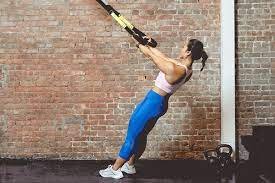
A dynamic and efficient exercise to target and improve your biceps is the suspension trainer biceps curl. Using a suspension trainer, this tough calisthenics bicep exercise offers a different take on classic bicep curls by working your stabilizing muscles and strengthening your core.
Including this exercise in your routine is a great way to strengthen your arm muscles and improve your general stability. It’s also a great option for people looking for a full upper body workout.
Brief Description:
Suspension trainer bicep curls entail doing bicep curls while wearing a suspension trainer, like TRX. You may customize the resistance and tailor the workout to your fitness level by varying the length of the straps and your body posture.
Step-by-Step Guide:
1. Setup: Make sure the suspension trainer is firmly secured and adjust it to the proper length.
2. Body Positioning: Lean back, causing tension in the straps, while standing with your back to the anchor point and holding the handles with an underhand grip.
3. Curling action: Bring your hands up to your shoulders and bend your elbows to start the curling action.
4. Full Contraction: To keep control at the peak of the exercise, clench your biceps.
5. Return to Start: Slowly bring your body back to the beginning while defying the suspension trainer’s pull.
Include suspension trainer bicep curls in your calisthenics bicep workout regimen to develop well-defined biceps and enhance your general strength and stability.
7. Isometric Towel Curls

Towel curls that are isometric are an excellent way to build strong biceps and increase arm strength generally. This underappreciated calisthenics bicep exercise in the fitness world combines the advantages of isometric contractions with the ease of use of a towel, resulting in a demanding but doable exercise appropriate for all skill levels.
Brief Description:
To target and engage the biceps, try the simple but very powerful isometric towel curl workout. By tugging against a towel, all you need to produce resistance and increase muscle activation and endurance is that towel. This is a complete workout because it works the stabilizing muscles in addition to the biceps.
Step-by-Step Guide:
1. Preparation: Start by placing your feet shoulder-width apart and placing your hands shoulder-width apart in front of you while clutching a towel.
2. Towel Tension: Pull the towel apart with both hands to produce tension, which works your biceps.
3. Isometric Hold: To maintain the tension, hold the towel at chest height for a prolonged amount of time while flexing your arms.
4. Intensity Adjustment: Tighten the towel or reposition your hands to make the task harder.
5. Release: Breathe out and repeat the isometric holds for a few sets, extending them progressively as your strength increases.
Include isometric towel curls in your calisthenics bicep workout regimen to see a noticeable improvement in the strength and definition of your biceps and entire arm.
8. Self-Resisted Curls

The curl that requires self-generated resistance is a dynamic and demanding workout that enables people to increase their bicep strength. This is a different kind of exercise that works the entire upper body by engaging multiple stabilizing muscles in addition to isolating and intensely targeting the biceps.
Brief Description:
The self-resisted curl is a self-induced challenge that encourages muscular activation and growth. It involves the person restraining their own arm movement. Not only is this calisthenics bicep workout accessible to anyone, since it doesn’t require any extra equipment, but it’s also a very effective way to build bicep strength.
Step-by-Step Guide:
1. Starting Position: Arrange your feet shoulder-width apart and hold out your arms in front of you.
2. Curling action: Lift your hands toward your shoulders and flex your biceps to start the curling action.
3. Self-Resistance: To create tension, curl while using your opposite hand to resist the upward movement.
4. Hold and Repeat: At the top of the curl, hold the resistance for a little period of time before lowering your hands again.
5. Switch Sides: To ensure balanced development, perform the exercise using the opposing hand as resistance.
Include self-resisted curls in your regimen to build muscular, well-defined biceps while providing your body with a fresh, difficult exercise.
9. Biceps Push-Ups

With the energizing Biceps Push-Up, you can start your trip to toned biceps. This dynamic calisthenics bicep workout targets your biceps for a full upper body workout while also testing your chest and triceps. Your exercise regimen will become more versatile with this focused exercise, which also promises to develop arm strength and definition.
Brief Description:
A small variation on the standard push-up, the Biceps Push-Up emphasizes hand positioning to optimize bicep engagement. This workout improves upper body strength and endurance while also promoting muscle growth.
Step-by-Step Guide:
1. Starting Position: Spread your hands slightly wider than shoulder-width apart and start in the plank position.
2. Hand Placement: Bring your hands closer together so that your biceps receive the majority of the force.
3. Downward Phase: Keep your elbows close to your sides as you lower your body toward the floor.
4. Upward Phase: Feel your biceps contract as you push yourself back up to the starting position.
5. Repeat: Focus on controlled movements while completing a certain number of repetitions of the exercise.
Include Biceps Push-Ups in your routine to develop stronger upper body and sculpted arms. Take your workout to the next level and see the miraculous results on your biceps.
10. Doorway Curls
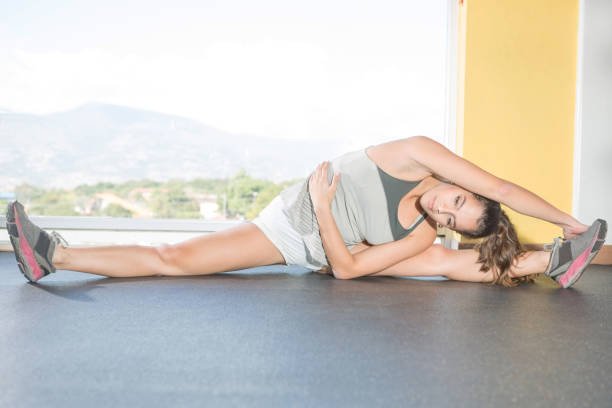
Give your at-home workout a makeover by adding Doorway Curls, a potent and practical calisthenics bicep exercise. This exercise uses a doorway to increase resistance for a different take on the classic bicep curl. Doorway curls are a flexible addition to your arm-strengthening repertoire because they are effective and accessible to people of all fitness levels.
Brief Description:
Doorway curls are a great way to strengthen your biceps because you can use a door frame. This workout promotes muscular growth and definition by focusing on the biceps. For the best bicep engagement and regulated motions, the doorway acts as a stabilizing force.
Step-by-Step Guide:
1. Setup: Place your feet shoulder-width apart and face an open doorway.
2. Hand Placement: Hold the door frame at shoulder height with both hands, palms facing you.
3. Curling action: Bend your elbows and draw your body toward the door frame to start the curling action.
4. Contract the Biceps: To guarantee a complete range of motion, contract your biceps at the peak of the exercise.
5. Return to Start: Feel the strain in your biceps as you slowly lower your body back to the starting position.
6. Repeat: Carry out the exercise under control for a predetermined number of repetitions.
Include Doorway Curls in your calisthenics bicep workout regimen to achieve well-defined and sculpted biceps. With this simple and efficient exercise, you may improve your at-home workout experience.
11. Pelican Curl
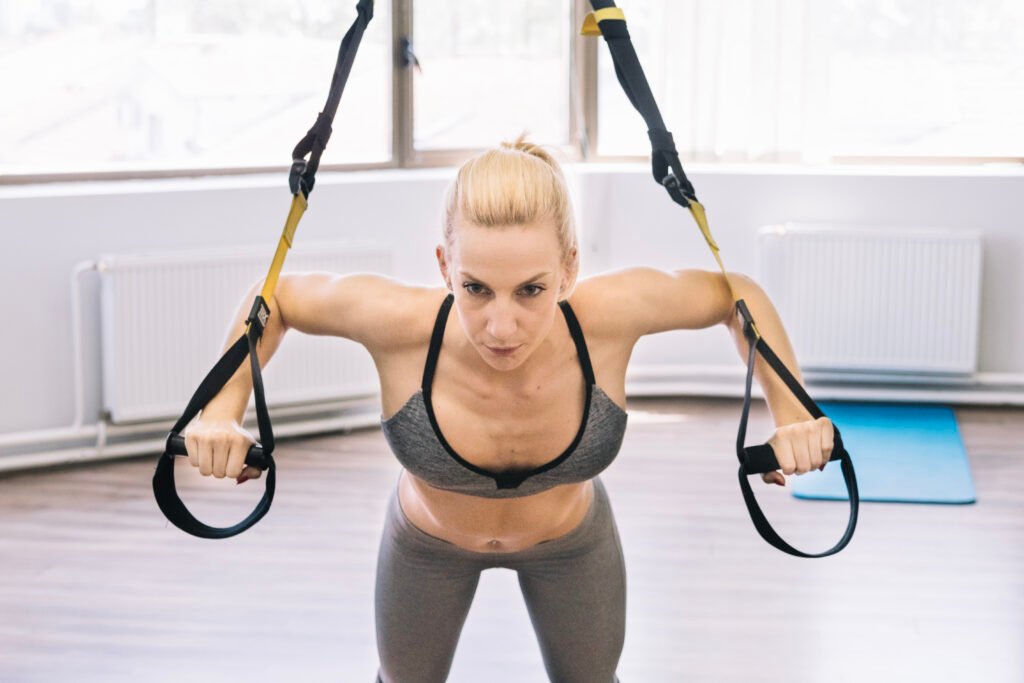
The Pelican Curl is a complex exercise that will give your calisthenics biceps a burn unlike any other. This exercise is a highlight of any full-body regimen since it works your biceps and tests your strength and stability in a different way.
Brief Description:
The Pelican Curl is an unusual yet very powerful bicep exercise used in calisthenics. It entails hanging from a horizontal bar with your arms outstretched, bringing your body up toward the bar with a controlled curling action. This targets and increases the biceps’ involvement, producing remarkable effects.
Step-by-Step Guide:
1. Setup: Look for a horizontal bar that is strong enough to hold your body weight.
2. grasp: With your arms outstretched, hang from the bar using an overhand grasp.
3. Curling Motion: Pull your torso upward toward the bar while flexing your biceps to start the curl.
4. Squeeze and Hold: To enhance muscular activation, squeeze your biceps at the peak of the exercise and hold for a brief period of time.
5. Lowering Phase: Return your body to the starting posture gradually while keeping your composure.
6. Repeat: As your strength increases, progressively increase the number of repetitions you aim for.
The Pelican Curl is a dynamic exercise that will test your limitations and change your calisthenics experience. Unlock the full potential of your biceps.
12. Behind-the-Neck Chin-Up
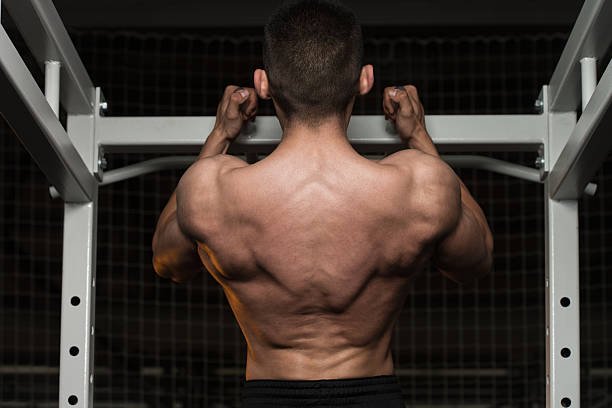
The complex known as the Behind-the-Neck Chin-Up works multiple muscle groups to transform your upper body strength. For a complete workout, this compound action works the trapezius muscles in addition to the biceps and lats.
Brief Description:
The Behind-the-Neck Chin-Up is a dynamic workout in which you raise your body upward until the bar reaches the back of your neck while holding onto the pull-up bar with a narrow, palms-facing grip. This particular variant improves general muscle definition and increases upper back engagement.
Step-by-Step Guide:
1. Beginning Position: Hang with your hands facing you from the pull-up bar using a narrow grip.
2. Start the Pull: Draw yourself up, trying to reach the back of your neck with the bar.
3. Controlled Descent: Extend your arms fully and lower your body back down in a controlled manner.
4. Repeat: Keeping your form correct the entire time, aim for a certain amount of repetitions.
With the tough yet satisfying Behind-the-Neck Chin-Up, you can unleash the full potential of your upper body and add a new skill to your fitness repertoire.
Crafting an Effective Calisthenics Bicep Workout
Developing strong biceps with calisthenics calls for a planned exercise program and mentor. Methodical Guide:
1. Foundational Exercises: Start with traditional calisthenics exercises, such as chin-ups and pull-ups, which work the entire upper body in addition to the biceps.
2. Advanced Movements: For specific bicep development, move on to more difficult exercises like head bangers, commando pull-ups, and one-arm chin-up negatives.
3. Isometric Holds: Include isometric workouts to highlight muscular endurance and control, such as ring curls and pseudo planche push-ups.
4. Supersets: To increase the intensity and encourage muscular development, intelligently combine exercises for supersets.
Advice for Peak Efficiency:
1. Consistency: For best results, perform the exercise two to three times a week.
2. Progressive Overload: Go to harder versions or add more repetitions and sets to gradually up the challenge.
3. Correct Form: To guarantee focused muscle engagement and avoid injuries, pay close attention to maintaining correct form.
4. Rest and healing: To promote muscular growth and healing, give yourself enough time off in between workouts.
How to Create an Effective Calisthenics Bicep Workout:
Developing an effective calisthenics bicep workout requires carefully combining fundamental exercises, progressive overload, and focused movements. This method improves the overall appearance of the upper body in addition to strengthening the biceps.
Incorporate these effective calisthenics bicep workouts into your program to advance your fitness goals. Every exercise, from sophisticated Pelican Curls to traditional chin-ups, is carefully selected to enhance specific muscle growth and general strength.
You will have a deep understanding of how these workouts enhance both functional ability and aesthetic appeal as you delve into the nuances of biceps anatomy. Accept constancy, increasing difficulty, and correct form to see the remarkable effects on your upper body strength and biceps.
FAQs
1. How often should I work out my biceps using calisthenics?
Answer: For best results, try two to three sessions a week, giving your muscles enough time to repair and expand.
2. Can novices use these workouts as part of their routine?
Answer: Absolutely, the guide offers basic workouts with advancement options for all fitness levels.
3. Are weightless calisthenics bicep workout effective?
Answer: Yes, these workouts use your own body weight as resistance, which helps you build strength and muscle.
4. Why is variety in angles and grips so important?
Answer: Using a variety of grips and angles, you can target different parts of the biceps for balanced development and complete muscle engagement.
5. How can I avoid getting hurt when working out my biceps with calisthenics?
Answer: To avoid injuries, put emphasis on good form, progressively increase challenge, and give yourself plenty of relaxation.
6. Can arm growth through calisthenics training for the biceps replace traditional weightlifting?
Answer: Yes, these workouts offer good substitutes that encourage toned arms without requiring pricey exercise gear.
Relevant External Links
1. https://www.pullup-dip.com/blogs/training-camp/calisthenics-exercises-biceps
2. https://bodyweighttrainingarena.com/calisthenics-bicep-workout
3. https://betterme.world/articles/calisthenics-bicep-workout

